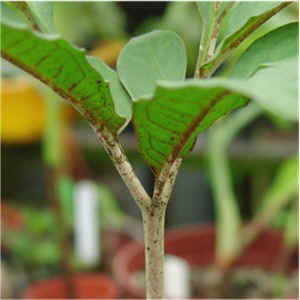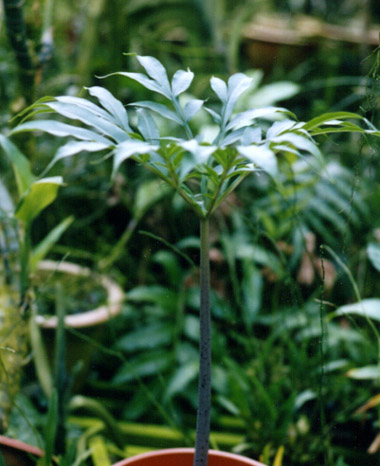Aroids I
Amorphophallus
蒟蒻,
魔芋
Aroids
are monocots (like orchids and grasses) distributed throughout the world in
temperate and tropical habitats and are greatly diverse in forms and habits. For
more information, I have to direct you to the International
Aroid Society site which has the best coverage of the family in the
web.
Amorphophallus is an interesting aroid from the old world - it consists of a
tuber that throws up a single leaf that is usually highly divided, hence looking
like a papaya tree sometimes. Many of them
are decicuous and usually, the
bloom appears after the leaf dies down - and this bloom may be the one of the
largest or tallest in the world eg for A. titanum and A. gigas or decue silvae.
The rather evil looking bloom and its accompanying offensive smell is meant to
attract flies or dung beetles but has earned them the name of "Corpse flower"
(Indonesian for A. titanum) and "Demon Yam" (Chinese name for this
genus) amongst indigenous people. More can be found in the IAS
site. Closely related plants include the Dracontiums of the new world,
Pseudodrancontiums of IndoChina and the much smaller Typhoniums.
In Malaysia,
the common species A. prainii and A. paenifolius are called likir. The
indigenous Semang of Perak (Malaysia) expressed the juice from the tuber and is
used in their poison hunting dart after mixing with the juice of Upas tree (Antiaris
toxicaria). Perhaps the calcium oxalate crystals in the sap stimulate increased
blood flow and hasten effect of the poison. Tubers are also used as food after proper cooking, especially for A.
paenifolius and bulbifer - non-acrid cultivars have been used for this purpose -
pls refer to Dr Misra's website
for more information. Seeds of some of
the Thai species are also known to be used in curry making. In Chiang Mai, I
have also seen the bloom of the wild plant being sold as ingredients for
curry. A. konjak is also a widely
used health food in East Asia and is a good carbohydrate source for the
diabetic. See the Chinese website
for more.
|

|

Silently
and without warning, an Amorphophallus koratensis from Thailand
bloomed in October after a long dormancy. This species is found throughout
Indochina. It can be grown fairly easily using free draining soil
rich in humus - like all Amorphophallus, stop watering when its dormant.
|
|

|
An unknown
Amorphophallus from Thailand closely related to yunanensis , this has a very short red-brown flower stalk
and a pink spathe. |
|

|
I was hesistant but
Dr Hetterscheid assured me this is the white petiole form of the A. bufo, a native of dense forest of Peninsula
Malaysia. This plant is not easy to cultivate as they seem to prefer
constantly moist soil and yet can rot easily. |
|

|
Both of my Amorphophallus
variabilis bloom 1 week apart in July. This is a mid-size plant from Java, notice the long sterile
portion of the spadix in this species. Unlike many members of this family,
it has a plain green leaf and petiole. This robust plant is a common crop
in parts of Indonesia.
Once again, I
detect no smell - but suposedly it will only exude the famed odour
in the late evening and only for 2-3 hours or so. |
|
 
|
Amorphophallus
asterostigmatus is a very handsome even without bloom, with fine
deep green leflets and a silvery purple stem with spots. Seeds of this plant are reputed to be used for
curry making. The known natural occurence of this plant is Lop Buri in
Thailand
|
|

|
This
is the bloom of Amorphophallus sumawongii from Thailand, a recently
described species. This is a small plant and the bloom is only about 20cm
tall. It likes shade and high humidity during growing season and is
probably suitable for indoor culture.
|
|

|
Amorphophallus
muelleri is a common species throughjout SE Asia, there are many forms but
the bloom is more or less similar as shown.
This photo is from Dewey
Fisk, click on the photo to goto his website.
|
|

|
Rob
Mcclure has kindly agreed upon the usage of his photo of A. galbra
blooming from his home Down Under. This species is found in PNG and
Australia and is unique in its fruity fragrance- a rare virtue in
the world of stinking giants. My plants grow rapidly from seeds and
form white tubers 3cm in diameter after 1 year of growth - its
active phase of growth is in November to April.

|
Goto Aroids : Pg 2 / Pg
3 / Pg 4
Back to main
page









